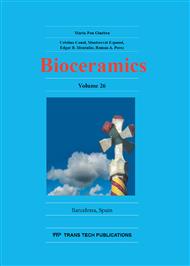p.390
p.397
p.402
p.408
p.414
p.420
p.426
p.430
p.435
Elastic Blocks: Hydrogel-Embedded Granules as Bone Grafting Substitutes
Abstract:
NanoBone® Block is the alternative to autogenous bone blocks and offers doctors a rapid, simple operating procedure in combination with a low risk of complications. Aim of this work was to develop a bone grafting block with elastic properties for dental and orthopedic surgery which is ready to use. An easy handling has to be connected with quick regeneration. Therefore, NB granules have been combined with an elastic hydrogel carrier based on Polyvinylpyrrolidone (PVP) and silica sol. Mechanical properties were optimized for an enhanced handling by cross linking and simultaneous sterilization of the PVP with gamma radiation. Cross linked PVP has the capability of swelling in water without being solved. To approve biocompatibility of adjusted material an in vivo study was analyzed using a standardized bone defect model in rat tibiae. Defect was filled with elastic bone grafting material. After 21 and 63 days rats were sacrificed and tibias analyzed. Histomorphological analysis showed an increased bone formation but even a decelerated resorption of elastic biomaterial. Quantitative compositional analysis showed a decrease in silicon content of granules as a process of matrix change.
Info:
Periodical:
Pages:
414-419
Citation:
Online since:
November 2014
Authors:
Keywords:
Price:
Сopyright:
© 2015 Trans Tech Publications Ltd. All Rights Reserved
Share:
Citation:


